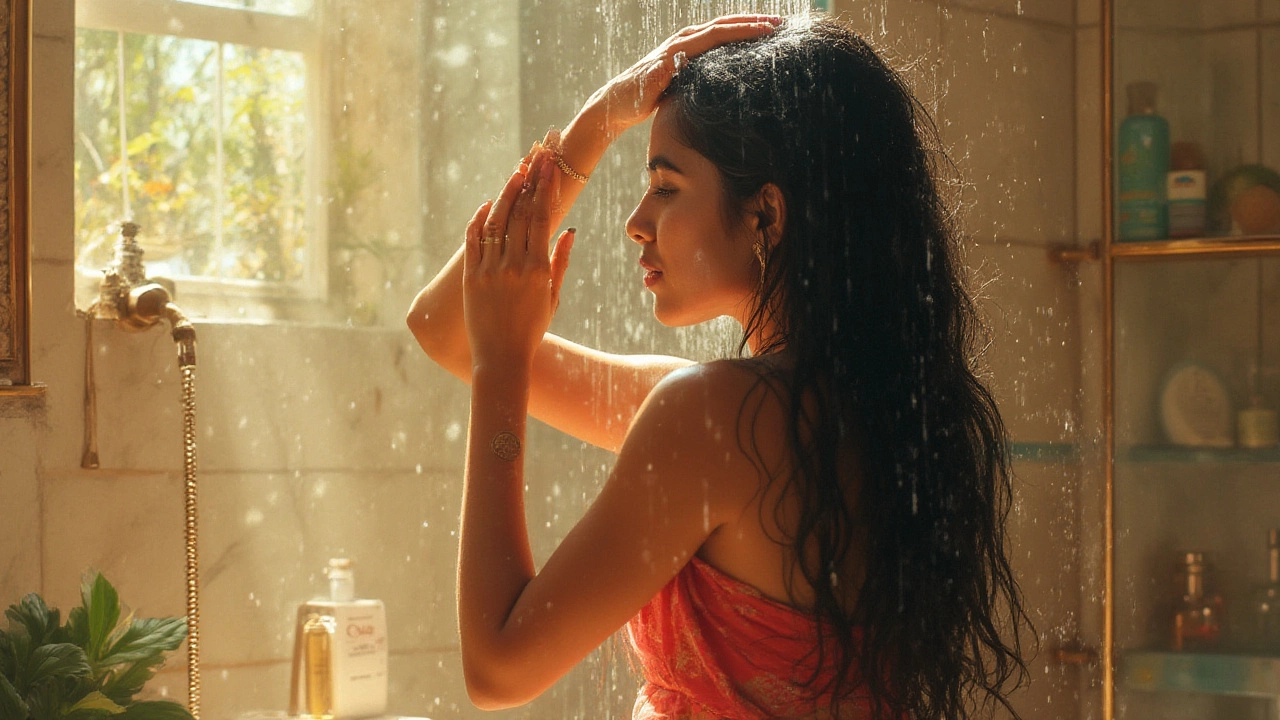
Hair isn’t just something that sits on your head. It’s a living timeline of late nights, sunny weeks, stress, and self-care. Ever noticed how one week you’re feeling like a goddess, and then one wrong product switch later, it feels like a haystack glued to your head? Here’s the wild thing: there’s no one golden rule for perfect hair—but there’s definitely a science-backed road map to make it thrive. The truth is, people still Google “best hair care routine” more than 450,000 times a month. Why? Because beauty aisles are packed with miraculous bottles, but no one tells you how to use them or even where to start. And let’s not ignore the stats: a 2023 survey by Statista showed that 61% of people admitted they don’t feel confident about their hair care knowledge.
The Foundation: How to Build Your Hair Care Routine
Let’s break the cycle of random product hopping. The perfect hair care routine always starts with spotting what your hair actually needs. Here’s a fact: All hair isn’t created equal. Between the genetics, the water you wash it with, your diet, and the tools you attack it with, everyone’s hair is basically a personalized science project. Here’s the quick version—that most hair pros swear by—a basic hair routine breaks down into three core steps: cleansing, conditioning, and protecting.
Hair care routine step one? Shampoo. But not all shampoos are created equal. You’ll want a sulfate-free option if your scalp is sensitive or your hair is curly, since sulfates can strip away natural oils. A big study from the Journal of Dermatology found regular sulfates can raise the risk of scalp irritation by almost 45%. For fine hair, volumizing shampoos can help, but coarse or curly hair loves nourishing, creamy ones that focus on moisture. And don’t be fooled by the myth of “wash, rinse, repeat.” If you don’t use much product, a single wash does the job for most. But if dry shampoo or heavy styling creams are daily go-tos, then yes—a second gentle cleanse matters.
Now conditioning. This isn’t just to make detangling less of a wrestling match; conditioners replenish moisture and smooth your cuticles. The trick is: apply just from the mid-length to the tips, never glop it onto your scalp. Weekly deep conditioning is a real game-changer. According to a 2024 survey by Allure, 40% of people who started using a weekly mask said their hair noticeably broke less during styling. Want a bonus? Try using a wide-tooth comb in the shower to spread product evenly.
Protection is next—and this is the step most people skip. Sun, pollution, your curling iron, and even hard water all beat up your hair’s structure. So, heat protectant sprays aren’t just marketing fluff. The American Academy of Dermatology says a single use can lower heat damage by up to 70%. And for anyone who lives in a city or spends hours on a flat iron: scarf or hat outdoors, and prep hair with a hydrating leave-in serum during dry heat months.
Here’s a little cheat sheet for building your core routine:
- Shampoo: 1-3 times a week, tailored to your scalp, not hair length.
- Condition: Every time you wash, focus on mid-length to ends.
- Mask: Once weekly for dry, colored, or curly hair.
- Leave-in: Use as a daily hydrator or protector.
- Heat Protection: Always before using blow dryers, curlers, or straighteners.
One final tip: your brush makes or breaks everything. Paddle brushes work for long, straight hair. Wide-tooth combs rule for curls. Natural bristle brushes are best for distributing oils, especially for thick or coiled textures. And detangle gently: yanking, especially on wet hair, is how split ends and breakage sneak in.

Daily, Weekly, and Monthly Habits for Healthy Hair
You can have all the best products, but habits matter just as much. Start with how you treat your hair when it’s wet. Hair stretches more when wet, and that means it’s primed for breakage if you’re rough. A microfiber towel or just an old soft T-shirt is way more hair-friendly than a regular towel that pulls and tugs at strands. Pat your hair dry, don’t rub. This tiny change is huge—one salon study found it cut split ends by up to 40% over six months.
Another habit: letting your scalp breathe. Tight buns, braids, or ponytails yank at follicles and can lead to a real thing called traction alopecia. You don’t have to retire your scrunchies, but mixing up styles and giving your scalp days off from tension makes a world of difference. Avoid elastic bands with metal because they catch and snap hair. Swap in gentle, coil-shaped hair ties, which are trending for a reason—they don’t dent your hair and prevent creases too.
Brushing technique counts. Start at the ends, not your scalp, and work up. This smoothes out knots safely, minimizing snapping. And clean your hairbrush every week! Build-up of oil and product in your brush can transfer dirt straight back onto fresh hair. Just pull out hair, and soak the brush in warm water with a few drops of shampoo. It’s such an easy step, but most people forget it.
The way you sleep impacts your hair, too. Cotton pillowcases can snag and rough up cuticles. That’s why people rave about silk or satin pillowcases. They’re not just an Instagram trend—Stanford dermatologists found reduced friction from silk slowed hair breakage and kept curls defined. If you prefer natural, even bamboo pillowcases work wonders and help with moisture. Tie hair up loosely or try a loose braid to avoid tangles, especially if you have long or textured hair.
Now, when it comes to washing, the sweet spot depends on your hair type and lifestyle. Those with fine, oily hair might need to wash every other day, but thicker, drier, or curly types can often stretch it out to once or twice a week. Over-washing strips away beneficial oils, leaving hair dull and lifeless. Dry shampoo is a handy in-between, just make sure to scrub your scalp to avoid residue build-up. And hot water may feel good, but stick to lukewarm or cool rinses; it keeps cuticles smooth and helps color stay vibrant if you dye your hair.
Ready for a little science? Here’s a table with daily, weekly, and monthly habits from leading trichologists (hair specialists):
| Frequency | Routine | Tip |
|---|---|---|
| Daily | Brush gently, use leave-in hydrator, protect from sun/heat | Sleep on silk, wear hat outdoors |
| Weekly | Deep conditioning mask, clarify build-up | Co-wash curls, scalp massage for blood flow |
| Monthly | Trim ends, protein treatment (if color-treated) | Evaluate product build-up, try an apple cider vinegar rinse |
Scalp care slips under the radar, but it’s crucial. A healthy scalp sets the stage for healthy hair. Massage your scalp a few minutes every shower, which boosts blood flow and encourages hair growth. If you notice flakes, redness, or itching, switch to a gentle, fragrance-free shampoo. Dandruff doesn’t mean you’re dirty; it usually points to an imbalance or mild reaction, so resetting your scalp care routine is smart.
“Healthy hair is an extension of a healthy scalp. Prioritize scalp care, and your hair will thank you.” — Dr. Amy McMichael, Professor of Dermatology, Wake Forest School of Medicine
Avoid overloading hair with too many styling products. Layering mousse, gel, hairspray, oil, and dry shampoo can leave hair heavy and limp. Use products intentionally, and always wash out heavy styling gunk at least once a week with a gentle clarifying shampoo. For an easy DIY clarifying rinse, mix one tablespoon of apple cider vinegar in a cup of water, pour it over your scalp post-shampoo, let it sit for a minute, and rinse. Your hair will feel lighter and look shinier.
Lastly, nutrition shows up in your strands. Iron, biotin, and protein all matter. If you’ve noticed extra shedding or slow growth, look at your diet—balanced meals, healthy fats, and plenty of water help inside-out hair health. Don’t trust miracle “hair vitamins” without backing—they aren’t magic and work best as part of a nutritious lifestyle, not in place of it.

Customizing Your Routine for Hair Type and Goals
No routine fits every head of hair, which is why you always see friends raving about a product that totally flops for you. Start with your hair texture and adjust. Here’s how to vibe with your own hair, not fight against it.
For straight hair: This type tends to get oily faster, so keeping your scalp clean is key. Go for lightweight shampoos and conditioners; heavy ones can easily weigh hair down. Shine sprays and leave-in mists add gloss without greasiness. Limit oils to the very tips, if at all.
For wavy hair: Lucky you, waves can be styled a million ways. The main thing is fighting frizz and adding definition. Use sulfate-free shampoos to stop dryness, deep-condition weekly, and spotlight curl creams or light gels. Scrunch hair with a t-shirt after washing and let it air-dry for the best texture. Don’t brush when dry—run fingers or a wide comb through damp hair instead.
For curly and coily hair: Hydration is non-negotiable. Use co-washing (cleansing with conditioner) more often than shampooing, since curls need those natural oils. Avoid harsh chemicals and heat when possible. A study by the International Journal of Trichology found that reducing heat styling to once a month, plus using extra moisture treatments, reduced breakage by 54%. Try scalp oils, weekly hair masks, and silk scarves for sleeping. The LOC method—leave-in, oil, cream—helps any curly girl lock in moisture.
For color-treated or bleached hair: Be extra gentle. Color damages the cuticle, so you need bonding, protein, and deep moisture. Switch to shampoos for color protection, skip daily washes, and invest in a bond-building treatment (like Olaplex No.3). UV protection sprays stop sun-fade, and heat protectants are a must. Use a bond-building or protein mask monthly to shore up strength. Ask for tiny trims every six weeks to stop split ends from taking over.
Think about your lifestyle, too. Swim a lot? Always rinse hair before and after the pool; chlorine strips protein and dries strands. If you live somewhere humid, anti-humidity serums and smoothing products are your best friends. If your hair is thin and limp, avoid heavy oils and creams—they’ll flatten it. Instead, root-lifting sprays and volumizing mousses work wonders.
Stress, sleep, and hormones all show up in your strands. If you’re over-stressed, not sleeping, or taking certain meds, hair fall can spike. It’s normal to shed up to 100 hairs per day, but if you see bald spots or much more than that, check in with your doc. Hair reflects what’s happening inside.
Confused by all the advice? Go slow: introduce one new product or step at a time. Give it at least a month before you judge results. Keep a notes app or journal to track what’s working and what feels off. Hair loves routine, but it also loves a little seasonal change—switch up masks or heat protection as the weather flips from summer to winter.
To sum it up, the "best" hair care routine is about paying attention—to your texture, your scalp, your lifestyle, your goals. It’s not about hoarding the fanciest bottles, but building smart, targeted habits, and tweaking as you go. If your hair feels healthier, bouncier, or shinier than last month, you’re doing it right. Ask questions, experiment, and remember: your hair, your rules.
 Hair Care
Hair Care